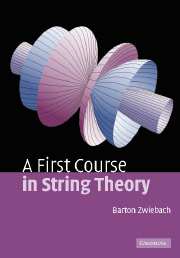Book contents
- Frontmatter
- Contents
- Foreword
- Preface
- Acknowledgements
- Part I Basics
- Part II Developments
- 14 D-branes and gauge fields
- 15 String charge, electric charge, and particle physics
- 16 String thermodynamics and black holes
- 17 T-duality of closed strings
- 18 T-duality of open strings
- 19 Electromagnetic fields on D-branes
- 20 Nonlinear and Born–Infeld electrodynamics
- 21 Covariant string quantization
- 22 String interactions and Riemann surfaces
- 23 Loop amplitudes in string theory
- References
- Index
14 - D-branes and gauge fields
from Part II - Developments
- Frontmatter
- Contents
- Foreword
- Preface
- Acknowledgements
- Part I Basics
- Part II Developments
- 14 D-branes and gauge fields
- 15 String charge, electric charge, and particle physics
- 16 String thermodynamics and black holes
- 17 T-duality of closed strings
- 18 T-duality of open strings
- 19 Electromagnetic fields on D-branes
- 20 Nonlinear and Born–Infeld electrodynamics
- 21 Covariant string quantization
- 22 String interactions and Riemann surfaces
- 23 Loop amplitudes in string theory
- References
- Index
Summary
The open strings we have studied so far were described by coordinates all of which satisfy Neumann boundary conditions. These open strings move on the world-volume of a space-filling D25-brane. Here we quantize open strings attached to more general D-branes. We begin with the case of a single Dp-brane, with 1 ≤ p < 25. We then turn to the case of multiple parallel Dp-branes, where we see the appearance of interacting gauge fields and the possibility of massive gauge fields. We continue with the case of parallel D-branes of different dimensionalities. Finally, we study configurations of intersecting D6-branes in the context of a compactification of type IIA superstrings on a six-torus.
Dp-branes and boundary conditions
A Dp-brane is an extended object with p spatial dimensions. In bosonic string theory, where the number of spatial dimensions is 25, a D25-brane is a space-filling brane. The letter D in Dp-brane stands for Dirichlet. In the presence of a D-brane, the endpoints of open strings must lie on the brane. As we will see in more detail below, this requirement imposes a number of Dirichlet boundary conditions on the motion of the open string endpoints.
Not all extended objects in string theory are D-branes. Strings, for example, are 1-branes because they are extended objects with one spatial dimension, but they are not D1-branes. Branes with p spatial dimensions are generically called p-branes. A 0-brane is some kind of particle.
- Type
- Chapter
- Information
- A First Course in String Theory , pp. 275 - 306Publisher: Cambridge University PressPrint publication year: 2004



